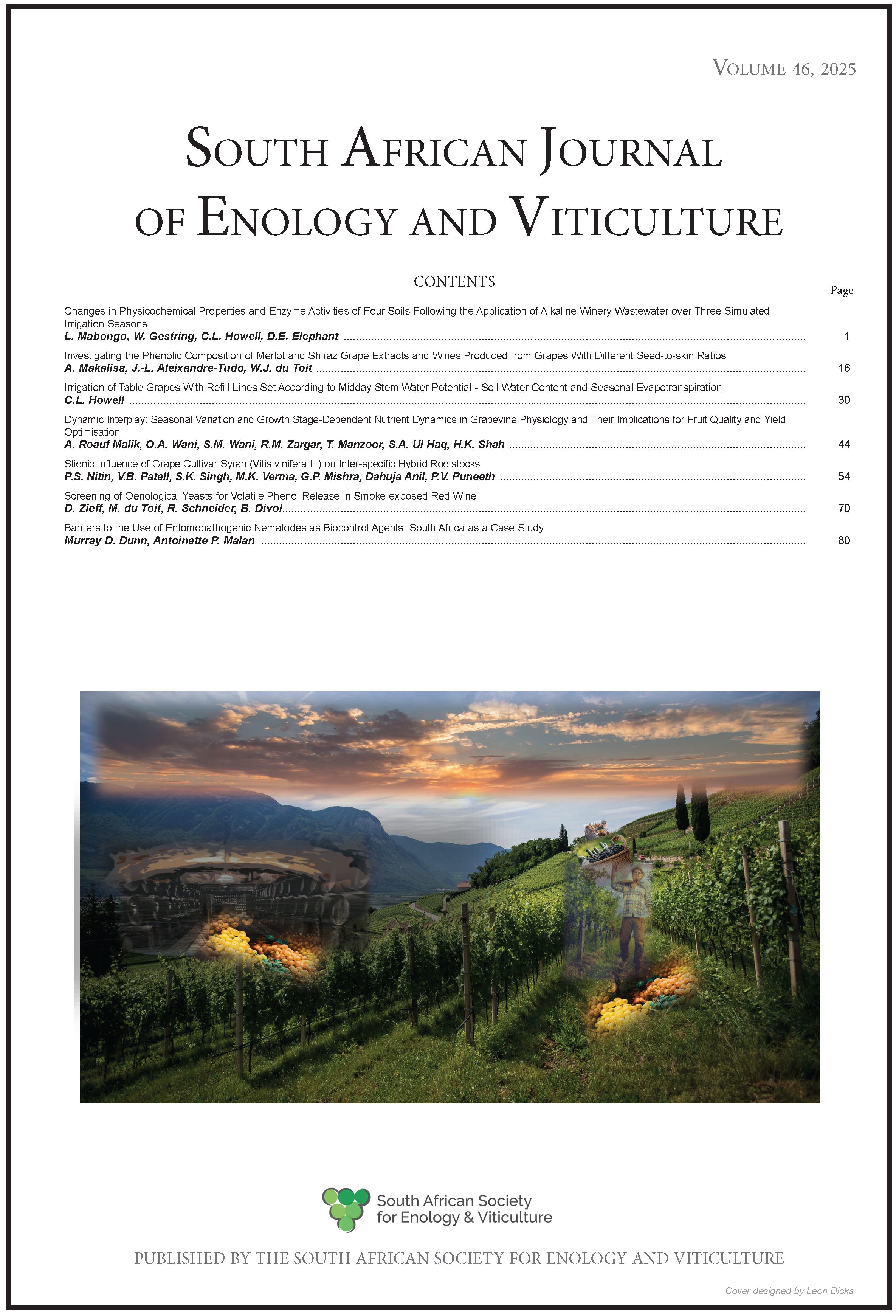Stionic Influence of Grape Cultivar Syrah (Vitis vinifera L.) on Inter-specific Hybrid Rootstocks
DOI:
https://doi.org/10.21548/46-6389Abstract
Rootstocks play a crucial role in commercial viticulture by mitigating abiotic and biotic stresses and enhancing
scion characteristics. Although Dogridge (Vitis champinii) is widely used for wine grapes, it is
generally unsuitable due to its tendency to accumulate higher potassium, phenols, and tannins, along with
lower acidity in berries. In this study, wine grape cultivar Syrah was evaluated on seven interspecific Vitis
rootstocks, namely SO4, 110R, P1103, 140Ru, Fercal, 3309 C and 41B, to assess their influence on the vegetative,
physiological, biochemical and quality traits. The experiment was conducted in a randomised block
design and the data obtained were analysed using SAS software. The experiment revealed significant variations
among rootstocks. Rootstock P1103 showed the earliest berry ripening, longer bunches (14.17 cm),
highest total phenols (158.43 mg 100 ml-1 GAE), total flavonoids (83.5 mg 100 ml-1 QE), and yield (9.26 kg
vine-1). Rootstock 110R induced the earliest budburst and produced longest internodes (10.08 cm), highest
berry TSS (22.26°Brix), total monomeric anthocyanins (406 mg 100 g-1 FW) and lowest juice acidity
(0.40%) along with dense trichomes- indicators of stress resistance. Rootstock 41B showed superior juice
recovery (72.45%), reducing sugars (14.91%) and leaf iron content (408.93 μg g-1). Rootstock SO4 induced
maximum cane length (131.89 cm), bunch weight (170.53 g), berry weight (1.487 g) and length (12.61 mm),
highest leaf chlorophyll ‘a’, total chlorophyll, and P (0.235%) and Zn content (96.67 μg g-1), along with the
highest peroxidase activity. These findings highlight the significant impact of rootstocks selection on Syrah
performance, emphasizing the need for long-term evaluation to determine their commercial suitability.
Downloads
Downloads
Published
Issue
Section
License
A copyright form will be e-mailed to the corresponding author when the manuscript has been accepted for publication.
In principle, the Author agrees to the following when he/she signes the copyright agreement:
I hereby assign to the SOUTH AFRICAN SOCIETY FOR ENOLOGY AND VITICULTURE (SASEV) the copyright of the text, tables, figures, supplementary material, illustrations and other information (the Material) submitted with the manuscript to be published in SOUTH AFRICAN JOURNAL OF ENOLOGY AND VITICULTURE (SAJEV) (the "Article"). The copyright becomes effective from the date the Article has been accepted for publication in SAJEV.
This is an open access journal, and the authors and journal should be properly acknowledged, when works are cited.
Author's may use the publishers version for teaching purposes, in books, theses, dissertations, conferences and conference papers.
A copy of the authors' publishers version may also be hosted on the following websites:
- Non-commercial personal webpage or blog.
- Institutional webpage.
- Authors Institutional Repository.
The following notice should accompany such a posting on the website: This is an electronic version of an article published in SAJEV, Volume XXX, number XXX, pages XXX - XXX, DOI. Authors should also supply a hyperlink to the original paper or indicate where the original paper (www.journals.ac.za/index.php/sajev/) may be found.
Authors publishers version, affiliated with the Stellenbosch University will be automatically deposited in the University's Institutional Repository SUNScholar.
Articles as a whole, may not be re-published with another journal.
The following license applies:
Attribution CC BY-NC-ND 4.0

